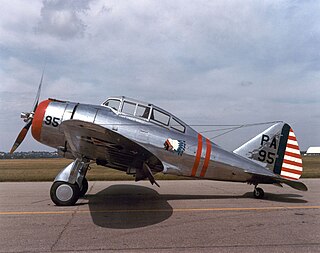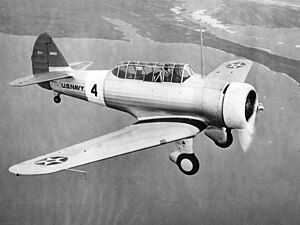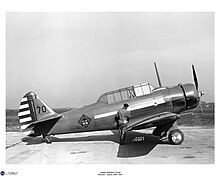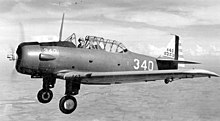
The Lockheed Model 9 Orion is a single-engined passenger aircraft built in 1931 for commercial airlines. It was faster than any American military aircraft of that time. Designed by Richard A. von Hake, it was the last wood aircraft produced by the Lockheed Aircraft Corporation.

The Seversky P-35 is an American fighter aircraft built by the Seversky Aircraft Company in the late 1930s. A contemporary of the Hawker Hurricane and Messerschmitt Bf 109, the P-35 was the first single-seat fighter in United States Army Air Corps to feature all-metal construction, retractable landing gear, and an enclosed cockpit.

The Vultee BT-13 Valiant is an American World War II-era basic trainer aircraft built by Vultee Aircraft for the United States Army Air Corps, and later US Army Air Forces. A subsequent variant of the BT-13 in USAAC/USAAF service was known as the BT-15 Valiant, while an identical version for the US Navy was known as the SNV and was used to train naval aviators for the US Navy and its sister services, the US Marine Corps and US Coast Guard.

The North American Aviation T-6 Texan is an American single-engined advanced trainer aircraft used to train pilots of the United States Army Air Forces (USAAF), United States Navy, Royal Air Force, Royal Canadian Air Force and other air forces of the British Commonwealth during World War II and into the 1970s. Designed by North American Aviation, the T-6 is known by a variety of designations depending on the model and operating air force. The United States Army Air Corps (USAAC) and USAAF designated it as the AT-6, the United States Navy the SNJ, and British Commonwealth air forces the Harvard, the name by which it is best known outside the US. Starting in 1948, the new United States Air Force (USAF) designated it the T-6, with the USN following in 1962. It remains a popular warbird used for airshow demonstrations and static displays. It has also been used many times to simulate various historical aircraft, including the Japanese Mitsubishi A6M Zero. A total of 15,495 T-6s of all variants were built.

The Pratt & Whitney R-1340 Wasp is an aircraft engine of the reciprocating type that was widely used in American aircraft from the 1920s onward. It was the Pratt & Whitney aircraft company's first engine, and the first of the famed Wasp series. It was a single-row, nine-cylinder, air-cooled, radial design, and displaced 1,344 cubic inches (22 L); bore and stroke were both 5.75 in (146 mm). A total of 34,966 engines were produced.

The Pratt & Whitney R-1535 Twin Wasp Junior was an engine used in American aircraft in the 1930s. The engine was introduced in 1932 as a 14-cylinder version of the 9-cylinder R-985. It was a two-row, air-cooled radial design. Displacement was 1,535 cu in (25.2 L); bore and stroke were both 5+3⁄16 in (132 mm).

The Pratt & Whitney R-985 Wasp Junior is a series of nine-cylinder, air-cooled, radial aircraft engines built by the Pratt & Whitney Aircraft Company from the 1930s to the 1950s. These engines have a displacement of 985 in3 (16 L); initial versions produced 300 hp (220 kW), while the most widely used versions produce 450 hp (340 kW).

The North American Aviation NA-16 was the first trainer aircraft built by North American Aviation, and was the beginning of a line of closely related North American trainer aircraft that would eventually number more than 17,000 examples, notably the T-6 Texan family.

The Boeing P-12 or Boeing F4B was an American pursuit aircraft that was operated by the United States Army Air Corps, United States Marine Corps, and United States Navy. It was the chief fighter aircraft in American service during the early 1930s but also used internationally. By the late 1930s it was replaced in front-line duty by newer designs, but it was still used for training into the early 1940s. Many variants of the aircraft were developed. In the 21st century a handful of surviving air frames are on display in museums.

The P-1 Hawk was a 1920s open-cockpit biplane fighter aircraft of the United States Army Air Corps. An earlier variant of the same aircraft had been designated PW-8 prior to 1925.

The Vought O2U Corsair was a 1920s biplane scout and observation aircraft. Developed by Vought Corporation, the O2U was ordered by the United States Navy (USN) in 1927. Powered by a 400 hp (298 kW) Pratt & Whitney R-1340 engine, it incorporated a steel-tube fuselage structure and a wood wing structure with fabric covering. Many were seaplanes or amphibians.

The Douglas O-2 was a 1920s American observation aircraft built by the Douglas Aircraft Company, powered by the Liberty engine of WW1 fame, with some later variants using other engines. It was developed into several version, with 879 being produced in total. It was used in combat by the Chinese Air Force in the 1930s and also was that basis for a successful mailplane version.

The Consolidated O-17 Courier was an observation and training aircraft used by the United States National Guard.

The Fairchild AT-21 was an American World War II specialized bomber crew trainer, intended to train crews in the use of power gun turrets or a gun on a flexible mount, as well as learn to function as a member of a crew. It had a brief career as a training aircraft before modified bombers took over this role.

The Curtiss-Wright CW-19 was a civil utility aircraft designed in the United States in the mid-1930s and built in small quantities in a number of variants including the CW-23 military trainer prototype.

The Loening OL, also known as the Loening Amphibian, was an American two-seat amphibious biplane designed by Grover Loening and built by Loening for the United States Army Air Corps and the United States Navy.

This article describes the different variants of the North American T-6 Texan.

The Boeing AT-15 was an American twin-engined bomber crew trainer designed and built by Boeing's Wichita Division. Only two prototypes, designated XAT-15, were built. Plans to build over 1,000 were cancelled on the United States' entry into the Second World War.

The Stearman XBT-17 was a prototype 1940s American two-seat low-wing monoplane primary trainer designed and built by Stearman Aircraft. It was evaluated by the United States Army Air Force in 1942 as the XBT-17.

The North American NA-64 is a low-wing single piston engine monoplane advanced trainer aircraft that was built for the French Air Force and French Navy, served with the Royal Canadian Air Force, and with the Luftwaffe as a captured aircraft during World War II.
























